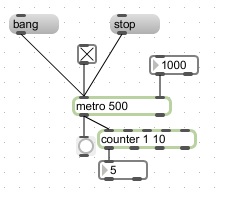Over the last few days I’ve begun to dig into Cycling 74’s Max 5. Here are my first impressions of the update. I haven’t yet performed with this version of the program or used it to run an installation, so I don’t have any information about stability or performance.
First the obvious change: the interface is bright and shiny–definitely not the clunky old Max look. I can’t say I’m immediately in love with it, but I do believe by the time I tweak the default settings a little I’ll be quite comfortable with the new look. I very much appreciate the options for changing the appearance of objects (even though some inspector windows are daunting when you first open them).
I love the usability features of Max 5:
• the search function
• the ability to double-click on a message in the Max window and be taken immediately to the part of the patch the message pertains to
• the keyboard shortcuts (damn, it’s so easy to get used to typing ‘n’ or ‘c’ or ‘m’ or ‘t’ or ‘b’ and having an object just show up). I suspect I’ll rarely use the gussied-up new object palette since the keystrokes are so convenient.
• support for long filenames (it’s the little things, really. OK, it’s the little, long things.)
I also love the new timing options, though I haven’t had a chance to use them extensively. I’m looking forward to creating polyrhythmic mayhem using a few transport objects all running at different tempi.
I like the idea of presentation mode, I just haven’t actually implemented it. I’ve always done something similar anyway: create a separate subpatch for just the controls I need, and since presentation mode only seems workable in a single subpatch I suspect it won’t radically change my workflow. Presentation mode would be more useful for me if any object in any subpatcher could be added to the presentation mode of a particular window. But that already sounds too complicated to manage (which object? in which subpatch? to which window?), plus the this is already possible using standard Max objects like send and receive.
I have mixed-feelings about the integrated documentation. I like the convenience of having help always at your fingertips but miss the portability of a pdf file. If you’re not running max, it’s tricky to get to the documentation. (Of course, you can always go to the Cycling 74 site.)
I’ve had a harder time with file-path issues and object conflicts in Max 5 than with other upgrades. This is likely just me and my convoluted setup. I have a bad habit of downloading almost every third-party Max object and freeware VST–not that I use them all. In fact, upgrades are often the times I evaluate the third-party objects that are essential to my work. The short list: LObjects, LitterPro, fiddle~, and a handful of others.
I’m looking forward to getting deeper into Max 5.

